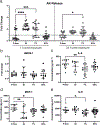Responses of reconstituted human bronchial epithelia from normal and health-compromised donors to non-volatile particulate matter emissions from an aircraft turbofan engine
- PMID: 35623573
- PMCID: PMC10024864
- DOI: 10.1016/j.envpol.2022.119521
Responses of reconstituted human bronchial epithelia from normal and health-compromised donors to non-volatile particulate matter emissions from an aircraft turbofan engine
Abstract
Health effects of particulate matter (PM) from aircraft engines have not been adequately studied since controlled laboratory studies reflecting realistic conditions regarding aerosols, target tissue, particle exposure and deposited particle dose are logistically challenging. Due to the important contributions of aircraft engine emissions to air pollution, we employed a unique experimental setup to deposit exhaust particles directly from an aircraft engine onto reconstituted human bronchial epithelia (HBE) at air-liquid interface under conditions similar to in vivo airways to mimic realistic human exposure. The toxicity of non-volatile PM (nvPM) from a CFM56-7B26 aircraft engine was evaluated under realistic engine conditions by sampling and exposing HBE derived from donors of normal and compromised health status to exhaust for 1 h followed by biomarker analysis 24 h post exposure. Particle deposition varied depending on the engine thrust levels with 85% thrust producing the highest nvPM mass and number emissions with estimated surface deposition of 3.17 × 109 particles cm-2 or 337.1 ng cm-2. Transient increase in cytotoxicity was observed after exposure to nvPM in epithelia derived from a normal donor as well as a decrease in the secretion of interleukin 6 and monocyte chemotactic protein 1. Non-replicated multiple exposures of epithelia derived from a normal donor to nvPM primarily led to a pro-inflammatory response, while both cytotoxicity and oxidative stress induction remained unaffected. This raises concerns for the long-term implications of aircraft nvPM for human pulmonary health, especially in occupational settings.
Keywords: Aerosol; Aircraft engine exhaust; Bronchial epithelial cell culture; Cellular response; Non-volatile particulate matter.
Copyright © 2022 The Authors. Published by Elsevier Ltd.. All rights reserved.
Conflict of interest statement
Declaration of competing interest
The authors declare that they have no known competing financial interests or personal relationships that could have appeared to influence the work reported in this paper.
Figures




Similar articles
-
Non-volatile particle emissions from aircraft turbine engines at ground-idle induce oxidative stress in bronchial cells.Commun Biol. 2019 Mar 5;2:90. doi: 10.1038/s42003-019-0332-7. eCollection 2019. Commun Biol. 2019. PMID: 30854482 Free PMC article.
-
Mitigation effects of alternative aviation fuels on non-volatile particulate matter emissions from aircraft gas turbine engines: A review.Sci Total Environ. 2022 May 10;820:153233. doi: 10.1016/j.scitotenv.2022.153233. Epub 2022 Jan 20. Sci Total Environ. 2022. PMID: 35066040 Review.
-
Reduction of Nonvolatile Particulate Matter Emissions of a Commercial Turbofan Engine at the Ground Level from the Use of a Sustainable Aviation Fuel Blend.Environ Sci Technol. 2021 Nov 2;55(21):14576-14585. doi: 10.1021/acs.est.1c04744. Epub 2021 Oct 18. Environ Sci Technol. 2021. PMID: 34662519
-
Toxicological evaluation of primary particulate matter emitted from combustion of aviation fuel.Chemosphere. 2024 Sep;363:142958. doi: 10.1016/j.chemosphere.2024.142958. Epub 2024 Jul 26. Chemosphere. 2024. PMID: 39069102
-
A review of health effects associated with exposure to jet engine emissions in and around airports.Environ Health. 2021 Feb 6;20(1):10. doi: 10.1186/s12940-020-00690-y. Environ Health. 2021. PMID: 33549096 Free PMC article. Review.
Cited by
-
Application of the market-ready NAVETTA electrodeposition chamber for controlled in vitro exposure with nano-scaled aerosols.Comput Struct Biotechnol J. 2024 Dec 17;29:1-12. doi: 10.1016/j.csbj.2024.12.008. eCollection 2025. Comput Struct Biotechnol J. 2024. PMID: 39872496 Free PMC article.
-
Toward Elimination of Soot Emissions from Jet Fuel Combustion.Environ Sci Technol. 2023 Jul 18;57(28):10276-10283. doi: 10.1021/acs.est.3c01048. Epub 2023 Jul 5. Environ Sci Technol. 2023. PMID: 37406187 Free PMC article.
-
Dispersion and Dosimetric Challenges of Hydrophobic Carbon-Based Nanoparticles in In Vitro Cellular Studies.Nanomaterials (Basel). 2024 Mar 27;14(7):589. doi: 10.3390/nano14070589. Nanomaterials (Basel). 2024. PMID: 38607123 Free PMC article.
References
-
- Abegglen M, Durdina L, Brem BT, Wang J, Rindlisbacher T, Corbin JC, Lohmann U, Sierau B, 2015. Effective density and mass–mobility exponents of particulate matter in aircraft turbine exhaust: dependence on engine thrust and particle size. J. Aerosol Sci. 88, 135–147.
-
- Al-Qurashi K, Boehman AL, 2008. Impact of exhaust gas recirculation (EGR) on the oxidative reactivity of diesel engine soot. Combust. Flame 155, 675–695.
-
- Bendtsen KM, Brostrøm A, Koivisto AJ, Koponen I, Berthing T, Bertram N, Kling KI, Dal Maso M, Kangasniemi O, Poikkimäki M, Loeschner K, Clausen PA, Wolff H, Jensen KA, Saber AT, Vogel U, 2019. Airport emission particles: exposure characterization and toxicity following intratracheal instillation in mice. Part. Fibre Toxicol. 16, 23. - PMC - PubMed
-
- Bendtsen KM, Gren L, Malmborg VB, Shukla PC, Tunér M, Essig YJ, Krais AM, Clausen PA, Berthing T, Loeschner K, Jacobsen NR, Wolff H, Pagels J, Vogel UB, 2020. Particle characterization and toxicity in C57BL/6 mice following instillation of five different diesel exhaust particles designed to differ in physicochemical properties. Part. Fibre Toxicol. 17, 38. - PMC - PubMed
MeSH terms
Substances
Grants and funding
LinkOut - more resources
Full Text Sources
Medical
Research Materials

